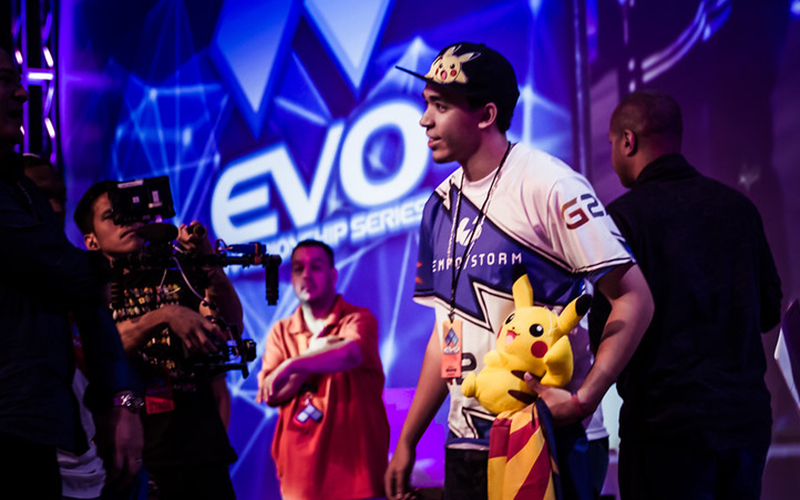
Jeffrey “Axe” Williamson, Arizona’s best “Super Smash Bros. Melee” player on stage at EVO 2015, the biggest annual fighting game tournament in the world. He finished 7th out of 1,869 players. (Image via Flickr)
PHOENIX – Stephen Shackleford had to make a tough decision when the COVID-19 pandemic accelerated in March.
As the co-founder of SAK Gaming, a grassroots esports organization that organizes tournaments in Arizona, Shackleford closed down the SAK Gaming Lounge, an esports venue in Tempe where high school and college-age Arizona residents gathered regularly to play games in the Nintendo franchise “Super Smash Bros.”
“That was the hub of Arizona smash,” Shackleford said. “That was the place where everyone went to congregate and to play smash, to meet new friends, to hang out with old ones. It was a really important place for a lot of people and now that’s gone.”
The @SAKGamingTV lounge was the home to future generation Melee players.
Really sad to see it go, but I'm grateful for the endless hours spent playing Melee in that venue pic.twitter.com/EmpRD9E1qV
— Tempo ?️I Axe (@TempoAxe) April 27, 2020
“Super Smash Bros.,” a platform fighting game, brings together dozens of Nintendo icons such as Mario, Pikachu, Kirby, and Donkey Kong to duke it out on various Nintendo landscapes. They battle on the infamous Rainbow Road from “Mario Kart” or a peaceful town from “Animal Crossing.”
“You have to remember that this is a Nintendo game, and we’re all playing wacky characters from ‘Mario’ and ‘Pokemon’ and stuff” said Jeffrey “Axe” Williamson, the best “Super Smash Bros. Melee” player in Arizona and the fourth best in the world. “I feel like it’s a lot more lighthearted than most esports.”
Smash has many ways the game can be customized and played and the competitive scene typically uses its own set of rules to make the game viable as an esport. The shutdown damaged the communal aspect of the game, and while online play used the same rules, it wasn’t as attractive to players or fans.
Games shut down
Shackleford said up to 50 people showed up every week to compete in small tournaments and hundreds attended monthly tournaments.
Then, the coronavirus arrived.
In early March, Vo planned to attend a regional tournament in Seattle. Before he left to visit family there, Washington had its first death.
Vo messaged a Facebook group to ask if the tournament would still be held. He was told it was fine to come.
Vo flew to Seattle but, as cases rose, the tournament was canceled.
“A week or two after that, we realized things were not going to go according to plan,” Vo said. “Even the tournaments we had on the horizon that we really thought we were going to be able to host, as they got closer, we realized that they weren’t going to happen.”
Dominos continued to fall.
Three monthly Melee events. Canceled.
A 16-24 person Melee invitational slated for Arizona’s best players. Canceled.
An event in Tempe expected to draw more than 100 players. Canceled.
Most esports, such as “League of Legends” or “Overwatch” can run tournaments online fairly easily because they are computer games. The “Smash Bros.” series is designed around offline play.
“Everything has been in-person, and it’s been slowly built up,” Williamson said. “Everyone is used to being social with each other, it’s a lot more welcoming, people aren’t really afraid to go up to someone else and say ‘hey, do you wanna play some games?'”
rip to the SAK gaming lounge, an amazing venue and a pillar for smash in the SW. I have a ton of great memories from all the tournaments I went to there. Walking in to the venue on a Friday night after the 7 hr drive from ABQ was always the best feeling pic.twitter.com/WlkNjMRKaC
— milo (@Yaddl_NM) April 24, 2020
Williamson said the social experience and energy of tournaments is just as important as the game, especially the local ones in his home state.
“Man, I really miss everyone. I miss the energy of tournaments, I miss the crowds, I miss when everyone really gets hyped for crazy combos and crazy hype,” Willamson said. “When I talk about the local level of tournaments, it’s a lot more personal, compared to nationals. A local tournament will have a few dozen people. I do miss how close everyone was – just being able to go there and just easily connect with people because you have a common interest.”
How the game is played
“Players get together and they compete in tournament formats to see who’s the best player,” Shackleford said. “With Super Smash Bros., it is usually one versus one or two versus two (Smash games typically have a maximum player count of four, but recent entries have allowed as many as eight), usually in physical gatherings of anywhere from 30 to 50 people” at local weekly tournaments.
Smash is unique as an esport as it is one of the few franchises where multiple games in the series are being played concurrently at a competitive level.
While a “Street Fighter” player will typically abandon the current title in the series once the new one launches, the Smash community is primarily divided between two games – “Super Smash Bros.Melee,” released for the Nintendo Gamecube in 2001, and “Super Smash Bros. Ultimate,” released for the Nintendo Switch in 2018.
Melee and Ultimate play differently.
“Melee is faster and more technical, and there are a lot more ways in which you can punish (mistakes) than in Ultimate,” said Andrew “Tai” Vo, considered one of the best Melee players in Arizona.
However, many prefer Ultimate do to its lower skill barrier, bigger, more balanced roster, and frequent updates and new downloadable content. Both Melee and Ultimate have their perks, so it largely comes down to personal preference. Each state has a dedicated community for both games, and Arizona is no exception.
“We definitely have one of the most active scenes for sure,” Shackleford said of Arizona’s status in the U.S. “I would rank us top five in terms of activity as well as skill level.”
When online doesn’t work
When the Melee and Ultimate scenes in Arizona tried running online tournaments, tournament organizers and players realized how different they were from playing in person.
The biggest issue is lag. Ultimate has around four-five frames of input delay, which is the delay in frames of animation between a player pressing a button or flicking a thumbstick on their controller and the ensuing command registering on screen. Using the often unreliable online services for the Nintendo Switch adds even more frames of input delay.
Compare it to a quarterback’s throwing motion slowing down or a base runner not stealing second as fast as usual.
“Usually, there’s a four-frame delay, and the online can add another 10 frames onto that,” said Logan “Logz” Sackrider, an Arizona-based Ultimate player who has been running tournaments online since the pandemic started. Sackrider said that Ultimate’s online essentially adds a ⅙ second delay to attacks, which can make a huge difference in what strategies can and cannot work.
Sackrider estimates about 90% of matches online are still usually determined by who is the better player. But in 10% of cases, the outcome can be determined by online connectivity, not human talent.
Players don’t like it. Shackleford learned that firsthand when he tried to organize online tournaments with the usual entry fees of offline events.
“Well, we gave online events a few tries using our traditional model,” said Shackleford. “Our normal model is to charge a $15 fee to enter the tournament, which is made up of a $10 administrative fee and then a $5 entry fee.”
Shackleford tested different models for running online tournaments. Some were more successful than others.
He quickly realized that people didn’t want to pay to compete in an online tournament.
“The first one was a free to enter tournament where we had over 100 attendees. And then the second one was a paid tournament that cost $10 and we had two attendees,” said Shackleford. “So that told us that there is not an interest in paying for online tournaments and that’s kinda the thing with Smash, it’s very much an in-person esport.”
Advances in tech
For Melee, a game which came out before online console multiplayer existed, the community had to do it themselves. In the last few years, the Melee community had been testing a form of online netplay through emulation software on computers.
This would allow players to play against each other online, playing the game on their computer rather than a gamecube. And some believe that netplay could be even faster than using a CRT monitor and a console. Yet it still has its drawbacks.
“Sometimes you’re at the mercy of your opponent’s internet connection.. But it’s still good enough that you can get good practice from it,” Williamson said. “But when you get really good and go to high level play, some options are taken from you on netplay. Great players will do microspacing, where you play really aggressive but staying out of range of your opponent’s attacks at the same time, and that kind of play is severely nerfed (weakened) in netplay.”
An uncertain future
It’s hard to know when offline tournaments in Arizona will start up again. Williamson said that he doesn’t feel comfortable attending tournaments until a vaccine for COVID-19, which causes the coronavirus, is available.
Shackleford said he wouldn’t be comfortable holding live events until August at the earliest.
“You can’t get people together, you can’t create these new experiences because everyone’s stuck at home,” said Shackleford. “It’s just not safe to bring people together right now.”
However, both stressed that they believe the Arizona communities – for Melee and for Ultimate – will survive and carry on.
“You just need people who are really passionate about it,” Williamson said. “Melee is going to be around even after the pandemic ends.”
“The community is going to come back even stronger with a strong desire for in person events, that is going to result in some really great experiences that will be happening with a whole new wave of players,” Shackleford said.
